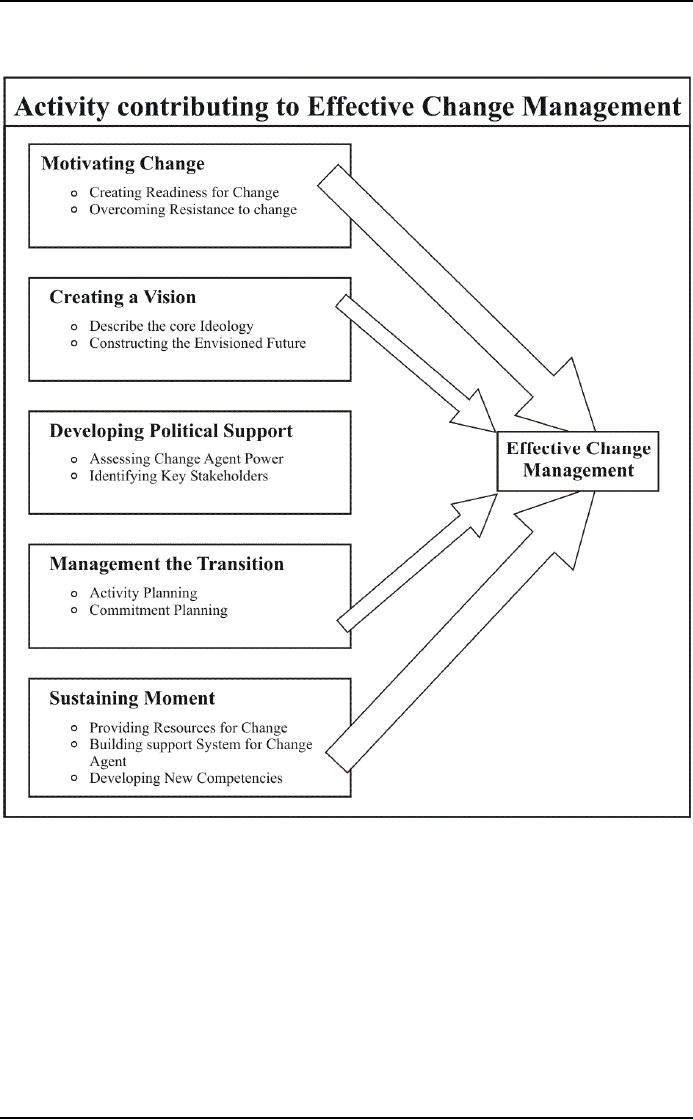 |

Organization
Development MGMT
628
VU
Lesson
23
Leading
and Managing Change
After
diagnosis reveals the cause of
problem or opportunities for development,
organization members
begin
planning and subsequently
leading and implementing the changes
necessary to improve organization
effectiveness
and performance. A large
part of OD is concerned with
interventions for
improving
organization.
Changes
can vary in complexity from the
introduction of relatively simple process
into a small work
group
to
transformation the strategies and
design features of the whole
organization. Although change
management
differs across situation, here we
discuss tasks that must be
performed in managing any
kind of
organization
change.
Overview
of Changes Activities:
The
OD literature has directed considerable
attention to leading and
managing change. Much of
the
material
is highly prescriptive, advising mangers
about how to plan and implement
organizational changes.
Traditionally,
change management has
focused on identifying sources of
resistance to change and
offering
ways
to overcome them. More
recent contribution has
challenged the focus on resistance
and has been
aimed
at creating vision and
desired future, gaining political
support for them, and
managing the transition
of
the organization toward them.
The
diversity of practical advice for
managing change can be
organized into five major
activities, as shown
in
figure 33. The activities
contribute to effective change management
and are listed roughly in the
order in
which
they typically are performed. Each
activity represents a key
element in change leadership.
The first
activity
involves motivating change
and includes creating a
readiness for change among
organization
member
and helping them address
resistance to change. Leadership
must create an environment in
which
people
accept the need for change
and commit physical and
psychological energy to it.
Motivation is a
critical
issue in starting change because
ample evidence indicates
that people and organization seek
to
preserve
the status quo and are
willing to change only when
there is compelling reason to do so.
The
second
activity is concerned with
creating a vision and is
closely aligned with
leadership activities.
The
vision
provides a purpose and reason
for change and describes the
desired future state.
Together, they
provide
the "why" and "what" of planned
change. The third activity
involves developing political
support
for
change. Organizations are
composed of powerful individuals
and groups that can either
block or
promote
change. The fourth activity
is concerned with managing the
transition from the current state
to
the
desired future state. It involves
creating a plan for managing
the change activities as well as
planning
special
management structure for operating the
organization during the transition. The
fifth activity
involves
sustaining momentum for change so
that it will be carried to
completion. This includes
providing
resources
for implementation the changes,
building a support system
for change agent, developing
new
competencies
and skills, and reinforcing
the new behaviors needed to implement the
changes.

Organization
Development MGMT
628
VU
Figure
33. Activity Contributing to
Effective Change
Management
Each
of the activities shown in Figure 33 is
important for managing
change. Although little
research has
been
conducted on their relative
contributions, organization leaders must
give careful attention to
each
activity
when planning and implementing organizational
change. Unless individuals
are motivated and
committed
to change, unfreezing the status quo
will be extremely difficult. In the
absence of vision,
change
is
likely to be disorganized and diffuse.
Without the support of powerful
individuals and groups,
change
may
be blocked and possibly sabotaged.
Unless the transition process is
managed carefully, the organization
will
have difficulty functioning
while it moves from the current
state to the future state.
Without efforts to
sustain
momentum for change, the organization
will have problems carrying
the changes through to
completion.
Thus, all five activities
must be managed effectively to
realize success.
Let's
now discuss more fully
each of these change
activities, directing attention to how
the activities
contribute
to planning and implementing organizational
change.

Organization
Development MGMT
628
VU
Motivating
Change:
Organizational
change involves moving from
the known to the unknown. Because the
future is uncertain
and
may adversely affect people's
competencies, worth and coping abilities,
organization members generally
do
not support change unless
compelling reason convince them to do so. Similarly,
organizations tend to
be
heavily invested in the status quo, and
they resist changing it in the face of
uncertain future benefits.
Consequently,
a key issue in planning for
action is how to motivate commitment to organizational
change.
As
shown in figure 33, this
requires attention to two
related tasks: creating
readiness for change
and
overcoming
resistance to change.
Creating
Readiness for
Change:
One
of the more fundamental axioms of OD is
that people's readiness for
change depends on creating
a
felt
need for change. This
involves making people so dissatisfied
with the status quo that
they are motivated
to
try new work process,
technology, or ways of behaving. Creating
such dissatisfaction can be
difficult, as
any
one knows who has tried to
lose weight, stop smoking, or
change some other habitual
behavior.
Generally,
people and organizations need to
experience deep levels of
hurt before they will
seriously
undertake
meaningful change. For example
IBM, GM and Sears
experienced threats to their very
survival
before
they undertook significant change
program. The following three
methods can help
generate
sufficient
dissatisfaction to produce
change:
1.
Sensitize
organizations to pressure for change.
Innumerable
pressures for change operate
both
externally
and internally to organizations. As
mentioned earlier, modern organizations
face
unprecedented
environmental pressures to change
themselves, including heavy
foreign
competition,
rapidly changing technology,
and the draw of global
markets. Internally pressures
to
change
include new leadership, poor
product quality, high
production costs and
excessive
employee
absenteeism and turnover. Before
these pressures can serve as
triggers for change,
however,
organizations must be sensitive to
them. The pressure must
pass beyond an
organization's
threshold of awareness if managers are to
respond to them. Many
organizations,
such
as Kodak, Apple, Polaroid
and Jenny Craig, set
their threshold of awareness too
high and
neglected
pressure for changes until
those pressures reached
disastrous levels. Organizations
can
make
themselves more sensitive to
pressure for change by
encouraging leaders to surround
themselves
with devil's advocate; by cultivating
external network that comprise people
or
organizations
with different perspective
and views; by visiting other
organizations to gain
exposure
to
new ideas and methods;
and by using external standards of
performance, such as competitions'
progress
or benchmarks, rather than the organization's
own past standards of
performance.
2.
Reveal
discrepancies between current and
desired states. In this
approach to generating a
felt
need for change, information
about the organization's current functioning is
gathered and
compared
with desired states of operation.
(See "Creating a Vision"
later for more
information
about
desired future states.)
These desired states may
include organizational goals and
standards,
as
well as general vision of a
more desirable future state.
Significant discrepancies between
actual
and
ideal states can motivate
organization members to initiate corrective
changes, particularly
when
members are committed to achieving
those ideals. A major goal of
diagnosis, as described
earlier,
is to provide members with
feedback about current organizational functioning so
that the
information
can be compared with goals
or with desired function
states. Such feedback
can
energize
action to improve the organization.
3.
Convey
credible positive expectation
for the change. Organization
members invariably
have
expectations
about the result of organizational changes.
The contemporary approach to
planned
change
described earlier suggest
that these expectations can
play an important role in
generating
motivation
for change. The expectations
can serve as a fulfilling prophecy,
leading members to
invest
energy in changes program that they
expect will succeed. When
members expect
success,
they
are likely to develop greater commitment
to the change process and to direct
more energy
into
the constructive behaviors needed to implement
it. The key to achieving
these positive
effects
is to communicate realistic, positive
expectation about the organizational changes.
Organization
members also can be taught about the
benefit of positive expectations
and be
encouraged
to set credible positive expectations
for the change
program.
Overcoming
Resistance to Change:
Change
can generate deep resistance
in people and in organization, thus making it
difficulty, if not
possible,
to
implement organizational improvement. At a personal level,
change can arouse
considerable anxiety
about
letting go of the known and
moving to an uncertain future. People
may be unsure whether
their
existing
skills and contribution will
be valued in the future, or have significant
questions about whether they

Organization
Development MGMT
628
VU
can
learn to function effectively
and to achieve benefits in the
new situation. At the organization level,
resistance
to change can come from
three sources. Technical
resistance comes from the
habit of following
common
producers and the consideration of sunk
costs invested in the status quo.
Political resistance
can
arise
when organization changes threaten powerful
stakeholders, such as top
executive or staff personal, or
call
into question the past decisions of
leaders. Organization change often
implies a different allocation of
already
scare resources, such as
capital, training budgets
and good people. Finally cultural
resistance takes
the
form of systems and
procedures that reinforce the status quo,
promoting conformity to existing
values,
norms,
and assumptions about how
things should operate.
There
are at least three major
strategies for dealing with
resistance to change.
1.
Empathy
and support. A
first step in overcoming resistance is to
learn how people are
experiencing
change. This strategy can
identify people who are having
trouble accepting the
changes,
the nature of their resistance,
and possible ways to
overcome it, but it requires
a great deal
of
empathy and support. It demands
willingness to suspend judgment and to
see the situation from
another's
perspective, a process called
active listening. When people feel that
those people who are
responsible
for managing change are
genuinely interested in their feelings
and perception, they are
likely
to be less defensive and
more willing to share their
concern and fears. This
more open
relationship
not only provides useful
information about resistance
but also helps establish the
basis
for
the kind of joint problem solving
needed to overcome barriers to
change.
2.
Communication.
People
resist change when they are uncertain
about its consequences. Lack of
adequate
information fuels rumors and
gossip and adds to the anxiety
generally associated
with
change.
Effective communication about changes
and their likely result
can reduce this
speculation
and
allay unfounded fears. It
can help members
realistically prepare for
change.
However,
communication is also one of the most
frustrating aspects of managing
change.
Organization
members constantly receive data
about people, changes and politics.
Managers and
OD
practitioners must think seriously about
how to break through this
stream of information.
One
strategy is to make change
information salient by communicating
through a new
different
channel.
If most information is delivered through
memos and emails, the change
information can
be
sent through meeting and
presentations. Another method that
can be effective during
large-
scale
change is to substitute change
information for normal operating
information deliberately.
This
sends a message that
changing one's activities is a critical
part of a member's
job.
3.
Participation
and involvement. One of the
oldest and most effective
strategies for overcoming
resistance
is to involve organization members directly in
planning and implementing
change.
Participation
can lead both to designing
high quality changes and to
overcoming resistance to
implementing
them. Members can provide a
diversity of information and ideas,
which can
contribute
to making the innovations effective and appropriate to
the situation. They also
can
identify
pitfalls and barriers to implementation.
Involvement in planning the changes
increases the
likelihood
that members' interest and
needs will be accounted for
during the intervention.
Consequently,
participants will be committed to implementing the
changes because doing so
will
suit
their interests and meet
their needs. Moreover, for
people having strong needs for
involvement,
the act of participation itself
can be motivating, leading to
greater effort to make
the
changes
work.
The
Life Cycle of Resistance to
Change:
Organization
programs such as downsizing,
reengineering and total
quality management
involve
innovations
and changes that will
probably encounter some degree of
resistance. This resistance
will be
evident
in individuals and groups in
such forms as controversy, hostility, and
conflict, either overt or
covert.
The response to change tends
to move through a life
cycle.
Phase
1
In
the first phase, there are
only a few people who see the
need for change and
take reform seriously, As
a
fringe
element of the organization, they may be
openly criticized, ridiculed, and
persecuted by whatever
methods
the organization has at its disposal
and thinks appropriate to handle
dissidents and force them to
conform
to established organizational norms. The
resistance looks massive. At this
point the change
program
may die, or it may continue to
grow. Large organizations
seem to have more difficulty
bringing
about
change than smaller
organizations. One of IBM's business
partners has said, for
example, that trying
to
get action from IBM is like
swimming through "giant pools of
peanut butter."

Organization
Development MGMT
628
VU
Phase
2
As
the movement for change begins to grow
the forces for and against
it become identifiable. The
change
is
discussed, and is more
thoroughly understood by more of the
organizations members. Greater
understanding
may lessen the perceived threat of the
change. In time, the novelty and
strangeness of the
change
tends to disappear.
Phase
3
In
this phase there is a direct conflict
and showdown between the forces
for and against the change.
This
phase
will probably mean life or
death to the change effort,
because the exponents of the change
often
underestimate
the strength of their opponents. Those in
organization who see change as
good and needed
often
find it difficult to believe
how far the opposition will
go to put a stop to the
change.
Phase
4
If
the supporters of the change are in power
after the decisive battles, they will see
the remaining resistance
as
stubborn and a nuisance. There is
still a possibility that the
resisters will mobilize enough
support to shift
the
balance of power. Wisdom is
necessary in dealing with
overt opposition and also
with the sizable
element
that are not openly
opposed to the change but
also not convinced of its
benefits.
Phase
5
In
the last phase, the resisters to the
change are as few and as
alienated as the advocates were in the
first
phase.
Although the description of the five
phases may give the
impression that a battle is being
waged
between
those trying to bring about
change and those resisting
the change (and sometimes this is
the
situation),
the actual conflict is usually
more subtle and may
only surface in small verbal
disagreements,
questions,
reluctance, and so
forth.
To
better understand the phases, see the
Five Phases of Resistance to
Change in Action.
Regardless
of how much resistance there
is to the organizations change program,
the change will to
some
extent
evolve through the five phases
described above.
Depending
on the change program, however, some of
the phases may be brief,
omitted, or repeated. If the
last
phase is not solidified, the
change process will move
into first phase again.
General Electric's retired
CEO,
John F. Welch, has
written:
People
always ask, "Is the change
over? Can we stop now? "
You've got to tell them,
"No, it's just begun."
They
must come to understand that
it is never ending. Leaders must
create an atmosphere where
people
understand
that change is continuing
process, not an
event.
The
Five Phases of Resistance to
Change
Phase
1
In
the 1970s the environmental movement
began to grow. The First
Earth Day was held in
1970.
Widespread
interest in environmental concerns
subsided during the 1980s.
Some political
officials
neglected
environmental concerns, and
environmentalists were often portrayed as
extremists and
radicals
(even
antidevelopment). The forces for
change were small, but
pressure for change
persisted through
court
actions,
elected officials, and group
actions.
Phase
2
Environmental
supporters and opponents became
more identifiable in the 1980s.
Secretary of the Interior
James
Watt was perhaps the most
vocal and visible opponent of
environmental concerns and
served as a
"lightening
rod" for pro-environmental
forces like the Sierra Club
and the Wilderness Society. As
time
passed,
educational efforts by environmental
groups increasingly delivered their
message. The public
now
has
information and scientific data
that enabled it to understand the
problem.
Phase
3
The
Clean Air Act passed by
Congress in 1990 represented the
culmination of years of
confrontation
between
pro- and anti-environmental
forces. The bill was
passed several months after national
and
worldwide
Earth Day events. Corporations criticized
for contributing to environmental
problems took out
large
newspaper and television ads to explain
how they were reducing
pollution and cleaning up
the
environment.
The "greening" of corporations became
very popular.
Phase
4
One
example is the confrontation between
Greenpeace (an environmental
group) and Shell Oil.
The
Greenpeace
group had been campaigning
for weeks to block the Royal
Dutch/Shell group from
disposing
of
the towering Brent Spar
oil-storage rig by sinking it deep in the
Atlantic Ocean. As a small
helicopter
sought
to land Greenpeace protesters on the
rig's deck, Shell blasted
high-powered water canons to
fend
off
the aircraft. This was all captured on
film and shown on TV around the
world. Four days after
the
incident,
Shell executives made a
humiliating about-face; they agreed to
comply with Greenpeace
requests
and
dispose of the Brent Spar on land.
The incident, like the Exxon
Valdez oil spill, shows how
high-
profile
cases can ignite worldwide
public interest.

Organization
Development MGMT
628
VU
Phase
5
Much
of the world now sees
environmentally responsible behavior as a
necessity. Near-zero automobile
emissions
are moving closer to a
reality. Recycling has
become a natural part of everyday
life for many
people.
But new ways to be
environmentally responsible are
still being sought.
Table of Contents:
- The Challenge for Organizations:The Growth and Relevance of OD
- OD: A Unique Change Strategy:OD consultants utilize a behavioral science base
- What an “ideal” effective, healthy organization would look like?:
- The Evolution of OD:Laboratory Training, Likert Scale, Scoring and analysis,
- The Evolution of OD:Participative Management, Quality of Work Life, Strategic Change
- The Organization Culture:Adjustment to Cultural Norms, Psychological Contracts
- The Nature of Planned Change:Lewin’s Change Model, Case Example: British Airways
- Action Research Model:Termination of the OD Effort, Phases not Steps
- General Model of Planned Change:Entering and Contracting, Magnitude of Change
- The Organization Development Practitioner:External and Internal Practitioners
- Creating a Climate for Change:The Stabilizer Style, The Analyzer Style
- OD Practitioner Skills and Activities:Consultant’s Abilities, Marginality
- Professional Values:Professional Ethics, Ethical Dilemmas, Technical Ineptness
- Entering and Contracting:Clarifying the Organizational Issue, Selecting an OD Practitioner
- Diagnosing Organizations:The Process, The Performance Gap, The Interview Data
- Organization as Open Systems:Equifinality, Diagnosing Organizational Systems
- Diagnosing Organizations:Outputs, Alignment, Analysis
- Diagnosing Groups and Jobs:Design Components, Outputs
- Diagnosing Groups and Jobs:Design Components, Fits
- Collecting and Analyzing Diagnostic information:Methods for Collecting Data, Observations
- Collecting and Analyzing Diagnostic information:Sampling, The Analysis of Data
- Designing Interventions:Readiness for Change, Techno-structural Interventions
- Leading and Managing Change:Motivating Change, The Life Cycle of Resistance to Change
- Leading and managing change:Describing the Core Ideology, Commitment Planning
- Evaluating and Institutionalizing Organization Development Interventions:Measurement
- Evaluating and Institutionalizing Organization Development Interventions:Research Design
- Evaluating and Institutionalizing Organization Development Interventions
- Interpersonal and Group Process Approaches:Group Process
- Interpersonal and Group Process Approaches:Leadership and Authority, Group Interventions
- Interpersonal and Group Process Approaches:Third-Party Interventions
- Interpersonal and Group Process Approaches:Team Building, Team Building Process
- Interpersonal and Group Process Approaches:Team Management Styles
- Organization Process Approaches:Application Stages, Microcosm Groups
- Restructuring Organizations:Structural Design, Process-Based Structures
- Restructuring Organizations:Downsizing, Application Stages, Reengineering
- Employee Involvement:Parallel Structures, Multiple-level committees
- Employee Involvement:Quality Circles, Total Quality Management
- Work Design:The Engineering Approach, Individual Differences, Vertical Loading
- Performance Management:Goal Setting, Management by Objectives, Criticism of MBO
- Developing and Assisting Members:Career Stages, Career Planning, Job Pathing
- Developing and Assisting Members:Culture and Values, Employee Assistance Programs
- Organization and Environment Relationships:Environmental Dimensions, Administrative Responses
- Organization Transformation:Sharing the Vision, Three kinds of Interventions
- The Behavioral Approach:The Deep Assumptions Approach
- Seven Practices of Successful Organizations:Training, Sharing Information